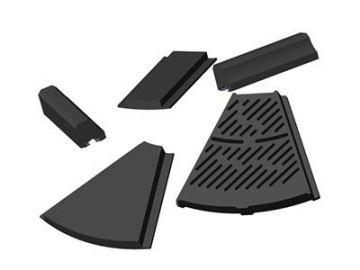Rod Mill Rubber Liner
A suitable rod mill rubber liner can be mounted to crush the materials and perform coarse grinding, which is the best replacement of the conventional manganese steel liner.
The rubber liner only can be adopted in the barrel of the rod mill that's why the end part should use the steel lining. The rod mill rubber liner features excellent abrasion resistance, light weight, easy installation, low energy consumption, long service life and low noise. As the superior component of the damp mill, the rubber liner has been widely used in mining, metallurgy, steel, nonferrous metal, phosphate and compound fertilizer, coal-water-slurry, flue gas desulfurization, building materials, grinding machine and etc.
The rod mill consists of feeding part, shell, discharging part, bearing part, transmission part and basic part. The steel cords are mounted inside the shell. The ores are crushed when the grinding medium (steel cords) are thrown from a certain height by the shell's centrifugal force. Then the ores will turn into ore sand and powder grinded by the grinding medium and shell liner. This is so called grinding process.
Both the rod mill and the ball mill are used for grinding ores and they are applicable to different processing situations. Generally speaking, the rod mill is suitable for coarse grinding and ball mill is suitable for fine grinding. Because the rod mill adopts steel cords as grinding media to perform line-contact grinding while the ball mill adopts steel ball to perform point-contact grinding process. The different contact way has decided the difference of grinded particle size.
The rod mill is less used than the ball mill and mainly applies to CWS, quartz sand, silica sand, sand gas, tungsten, potassium sodium feldspar, bauxite and etc. Though the ball mill is known for its wide application, the rod mill is the future trend of the industry. As the grinding technology changes, the concept of more crushing less grinding is accepted by an increasing number of people.
- Used in the reselection or magnetic separation plant of tungsten tin mine and other rare metal mine to prevent the damage caused by over crushing.
- When adopting two stage grinding process, if the first stage is grinding ores from 20~6mm to 3~1mm, the steel rod mill is more suitable than the ball mill and features higher production efficiency. Because the steel cord surface is smaller than that of the ball with the same weight, the ball mill is a better choice for the second fine grinding stage.
- As a replacement of the short head crusher under certain circumstances. When handling soft ores, especially the ores with high viscidity, and grinding them from 19~25mm (even 32mm) to 6~10mm, the rod mill is better than the short head ore crusher because the roll mill has simpler configuration, lower production cost and easier dust removal procedure.
- Used in the rod coal mill, which is applicable to cement, silicate product, new building material, fireproofing material, fertilizer, black or nonferrous metal separation and glass ceramic industry. The rod mill is capable of dry or wet grinding various ores and other grindable materials.
